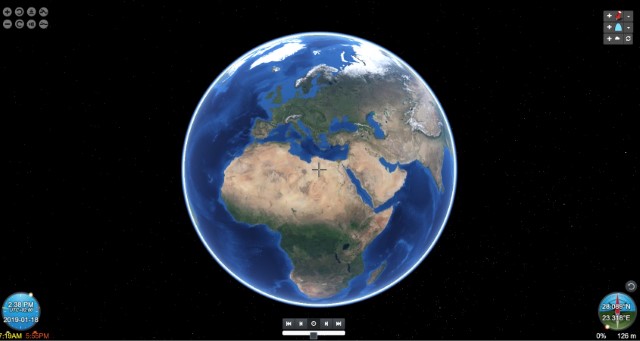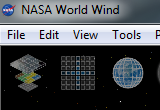

- #ADD SHAPES TO RENDERABLELAYER NASA WORLD WIND INSTALL#
- #ADD SHAPES TO RENDERABLELAYER NASA WORLD WIND ANDROID#

By default, BlueMarbleLayer is configured to retrieve imagery for May 2004 from the WMS at.

The order of layers in the list can be changed by dragging the layer names. Layers can be turned on and off by clicking the check box next to the layer name. Displays the layer list in a heads-up display in the viewport. Displays NASAs Blue Marble next generation imagery at 500m resolution from an OGC Web Map Service (WMS). public class LayerManagerLayer extends RenderableLayer implements SelectListener. Position( 25.0, - 85.0, 700000.0)) īoundaries. public class BlueMarbleLayer extends WmsLayer. label = "Placemark\n" + "Lat " + placemark. Placemark( position, false, placemarkAttributes)

baseUrl + "images/pushpins/plain-red.png" In your web browser, head to the address In either case, you should see in your web browser a globe like this:.In the command line console, run python -m rver.
#ADD SHAPES TO RENDERABLELAYER NASA WORLD WIND INSTALL#
Download and install Python version 3.X. In your web browsear, head to the address Another option is to use Python’s rver:. Execute the command http-server to start the server. In the command line console, run npm install http-server. Open a command line console in the root folder of your web app (where the ‘index.html’ file and your ‘./images’ folder is located). If you do not already have a web server, you can use a minimal development web server built in Node.js: If you’re not familiar with local testing servers, the Mozilla Development Network is a good place to start. The NASA World Wind Java (WWJ) platform is licensed under the Apache License, Version 2.0 (the 'License') you may not use this file except in compliance with the License. #ADD SHAPES TO RENDERABLELAYER NASA WORLD WIND ANDROID#
We have written a basic Web WorldWind app, but unlike the Java and Android versions of WorldWind, Web WorldWind is meant to be part of a web application, therefore we need a web server to visualize our work. The image files can be downloaded in here. exist in the same directory (if following our convention, the folder should be ‘./HelloWorldWind/images’). These need to be inside an ‘./images’ directory which needs to be a sibling of the library, i.e. Note that in order for both the corresponding icons of these controls to be displayed, as well as the low resolution Blue Marble imagery, we need their image files to be sourced locally. AVList addPropert圜hangeListener, addPropert圜hangeListener, clearList, copy, firePropert圜hange, firePropert圜hange, getEntries, getStringValue, getValue, getValues, hasKey, removeKey, removePropert圜hangeListener, removePropert圜hangeListener, setValue, setValues
Methods inherited from class clone, equals, getClass, hashCode, notify, notifyAll, wait, wait, wait. AVListImpl addPropert圜hangeListener, addPropert圜hangeListener, clearList, copy, firePropert圜hange, firePropert圜hange, getBooleanValue, getBooleanValue, getChangeSupport, getDoubleValue, getDoubleValue, getEntries, getIntegerValue, getIntegerValue, getLongValue, getLongValue, getRestorableStateForAVPair, getStringValue, getStringValue, getStringValue, getValue, getValues, hasKey, removeKey, removePropert圜hangeListener, removePropert圜hangeListener, setValue, setValues AbstractLayer createLayerConfigElements, getDataFileStore, getExpiryTime, getLayerConfigParams, getMaxActiveAltitude, getMa圎ffectiveAltitude, getMinActiveAltitude, getMinEffectiveAltitude, getName, getRestorableState, getScale, getScreenCredit, isAtMaxResolution, isEnabled, isLayerActive, isLayerConfigDocument, isLayerInView, isMultiResolution, isNetworkRetrievalEnabled, isPickEnabled, pick, preRender, render, restoreState, setDataFileStore, setEnabled, setExpiryTime, setMaxActiveAltitude, setMinActiveAltitude, setName, setNetworkRetrievalEnabled, setPickEnabled, setScreenCredit RenderableLayer addRenderable, addRenderable, addRenderables, clearRenderables, dispose, disposeRenderables, doPick, doPick, doPreRender, doPreRender, doRender, getActiveRenderables, getNumRenderables, getOpacity, getRenderables, onMessage, removeAllRenderables, removeRenderable, setOpacity, setRenderables One of them is RenderableLayer which contain shapes and the other is BasicTiledImageLayer containing raster images.








 0 kommentar(er)
0 kommentar(er)
